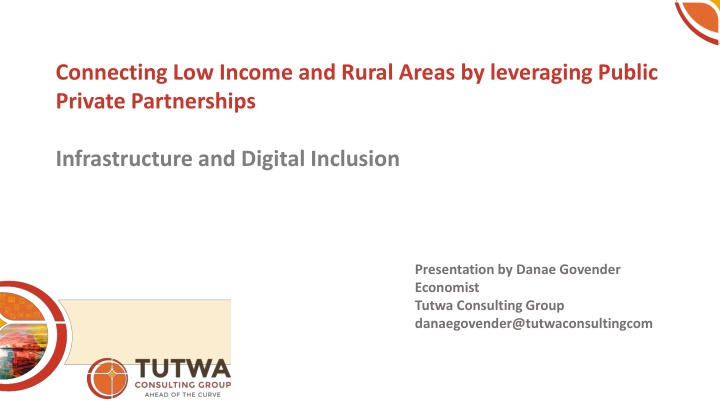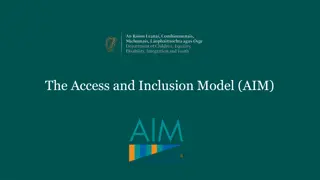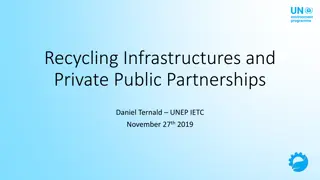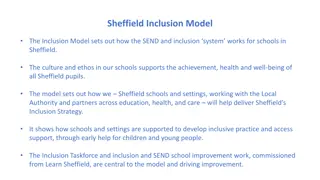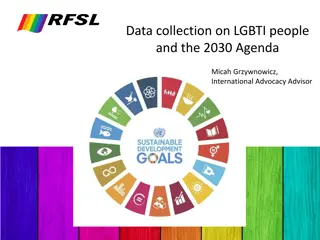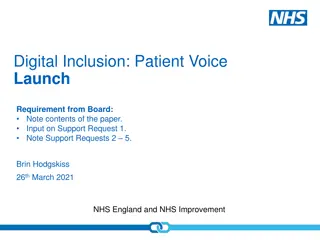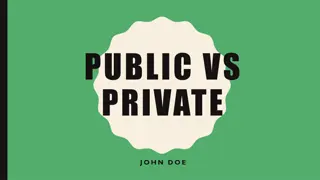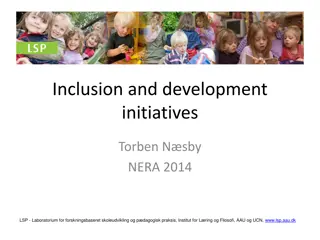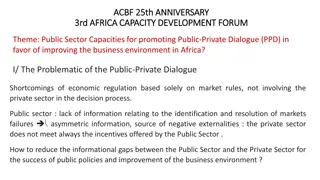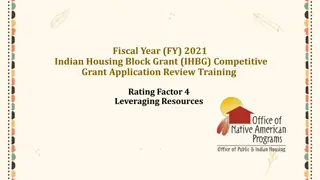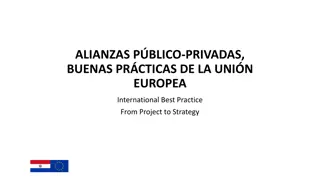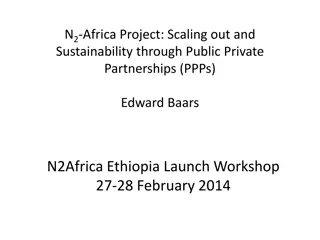Leveraging Public-Private Partnerships for Digital Inclusion
In this presentation by Danae Govender, an economist from Tutwa Consulting Group, the focus is on connecting low-income and rural areas through public-private partnerships, infrastructure development, and digital inclusion. Explore the importance of digital inclusion, the digital divide in South Africa, and strategies to enhance access to technology in underserved areas. Learn about the framework for PPP for rural connectivity and the role of affordable internet services, access to devices, digital literacy training, technical support, and online content in fostering digital inclusion.
Download Presentation

Please find below an Image/Link to download the presentation.
The content on the website is provided AS IS for your information and personal use only. It may not be sold, licensed, or shared on other websites without obtaining consent from the author.If you encounter any issues during the download, it is possible that the publisher has removed the file from their server.
You are allowed to download the files provided on this website for personal or commercial use, subject to the condition that they are used lawfully. All files are the property of their respective owners.
The content on the website is provided AS IS for your information and personal use only. It may not be sold, licensed, or shared on other websites without obtaining consent from the author.
E N D
Presentation Transcript
Connecting Low Income and Rural Areas by leveraging Public Private Partnerships Infrastructure and Digital Inclusion Presentation by Danae Govender Economist Tutwa Consulting Group danaegovender@tutwaconsultingcom
Outline What is digital inclusion, and the digital divide in South Africa Examination of Public-Private Partnerships Framework for PPP for rural connectivity 2
Digital Inclusion: What is it and why is it important? Refers to activities necessary to ensure equitable access to and use of information and communication technologies To participate economically Education, social services, health, political participation, and community participation Five elements of digital inclusion Affordable, quality broadband internet service Devices capable of accessing the internet Access to digital literacy training Technical support Online content and apps to encourage participation It must evolve with technological advancements and requires strategies and investments to eliminate barriers to accessing and using technology 3
Understanding South Africas digital divide Table 1 Internet access by place and area Place of access Area Percentage South Africa s digital divide is driven by three factors: Access to the related hardware Understanding the methods of digital communication Internet affordability Metro 14 At Home Urban 6,8 Rural 0,8 Metro 26,1 These issues hinder the country s ability to develop and reduce inequality as access to education and employment opportunities are impeded At work Urban 16,4 Rural 4,8 Metro 66,8 Using mobile device How to enhance digital inclusion? Access to public computers Free Wi-Fi hotspots Low-cost computer options Low-cost broadband Extending broadband services to rural areas Urban 71,6 Rural 52,9 Metro 28,2 Internet caf or educational facilities Urban 13,1 Rural 4,9 Source: ICASA, 2022 4
Public-Private Partnerships: What is it? A PPP refers to a relationship in which government resources and the private sector resources are deployed to achieve an objective for the greater good Unlike privatization, PPPs involves a role for public sector in a partnership with private sector players Includes different arrangements for the sharing of costs, responsibility, management, maintenance and ownership According to PPIAF, those modalities best suited to encourage private sector investment are Build Transfer (BT); Build Operate Transfer (BOT); Build Own Operate Transfer (BOOT) Stakeholders should have an overall view of the project objectives and decide whether a PPP is the best way to proceed This requires a realistic cost-benefit assessment 5
Public-Private Partnerships: VfM assessment The public sector comparator (PSC) model is a detailed and pragmatic assessment of all costs of the proposed PPP project with delay risks inflation effects, lifecycle costs, finance charges [and] operating costs included A net present value calculation is performed to compare the public sector cost against the price of PPP project The value for money (VfM) assessment is the difference in cost estimate between the traditional public delivery (public sector comparator) and the proposed cost of the PPP model VfM tests be conducted at each of the points when selecting the appropriate procurement methodology; when assessing the PPP bids; and at fitting stages through the duration of the contract 6
Public-Private Partnerships for connectivity PPPs in ICT focuses on technology and providing affordable internet services Economic viability for private sector players (or return on investment) Public sector- expansion of internet coverage + access to the necessary infrastructure and facilities In developing country contexts, ICT PPPs have become prominent Address infrastructure bottlenecks Expand benefits of modern communication technologies Ensure access to digital services and related economic opportunities in rural areas 7
Public-Private Partnerships for connectivity: Vietnam Two PPP ICT projects in Northern Vietnamese region of Loa Cai Both carried out by Intel and entities of the Vietnamese Ministry of Post and Telecom (VTF and VDC) USAID brought the partners together Intel s aim was to bring WiMAX to Vietnam and expand market for products that use its chips Intel also fostered development by deploying broadband technologies to remote areas, and VOIP Government s role was to provide underserved areas with access to telecommunications and to ensure future revenue streams At around the same time, the government enacted a universal telecoms service fund for these purposes 8
Public-Private Partnerships for connectivity: Vietnam The first WiMAX project was undertaken in a rural agricultural village as it allowed for inexpensive communications with cross-border trade partners in China Technology: Base station Almost 20 fixed-access WiMAX modems Wired and wireless VOIP phones Network infrastructure Modems were installed in key places (local post office, secondary schools, government offices, hospitals etc) and VOIP enabled phones were set up, providing both telephone and internet services 9
Public-Private Partnerships for connectivity: Vietnam The second Lao Cai project took place in the city of Sapa a rural, mountainous area Considered viable due to its eligibility to universal service funds from VTF A test project to assess feasibility in applying similar models in similar geographical regions Technology deployed The IPStar satellite system Around 10 modems Wireless VOIP phones and rugged laptops While the full socio-economic benefit of these projects have not been ascertained, it has been deemed a success as well as a worthwhile model for deployment 10
Frameworks and role players for an ICT PPP in South Africa b) Technology Framework a) Policy Framework c) Market Framework Executive Government Parliament Regulator Universal Access and Service Fund Fibre optics Wireless Broadband over powerline Satellite Telecentres Network providers Equipment manufacturers Universal Access and Service Fund Societies Subscribers 11
Proposed funding avenues Telecommunications companies Foreign direct investment Domestic financing Development finance institutions/Multilateral development banks Blended solutions 12
Concluding remarks There are clear benefits to be realized through access to ICT services The digital divide is evident in the case of South Africa PPPs offer a viable solution to service delivery issues of this nature The deployment of such frameworks have proven successful abroad, in other developing and emerging market economies The framework to realize the benefits of PPPs in connectivity requires commitment from all major role players Thus, the development and enforcement of such frameworks could offer South Africa a solution to bridging the digital divide 13
The end 14
References Center for Digital Equity What is digital Inclusion? Fife, E and Hosman, L (2014) Public Private Partnerships and the Prospects for Sustainable ICT Projects in the Developing World, Journal of Business Systems, Governance and Ethics, Vol 2, No 3 Khanyi Mlaba, How Is South Africa's Digital Divide Making Inequality Worse in the Country?, Global Citizen, 21 August 2021 Independent Communications Authority of South Africa (2022) The State of the ICT Sector Report of South Africa Rahman, S M A (2016) Prospects of PPP in Expanding ICT Services in Rural Bangladesh: A Case of Union Digital Center, International Journal of Economics and Finance; Vol 8, No 2 Williams, I (2012) Infrastructure Development: Public Private Partnership Path for Developing Rural Telecommunications in Africa, Journal of Technology, Management and Innovation, Vol 7, No 2 15
